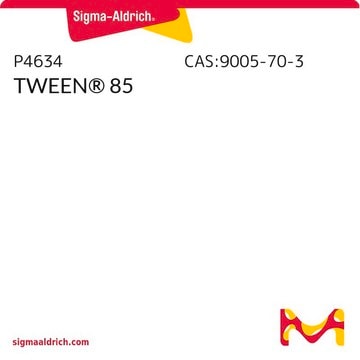Products may be shipped at a different temperature than the recommended long-term storage temperature. If the product quality is sensitive to short-term exposure to conditions other than the recommended long-term storage, it will be shipped on wet or dry-ice. If the product quality is NOT affected by short-term exposure to conditions other than the recommended long-term storage, it will be shipped at ambient temperature. As shipping routes are configured for minimum transit times, shipping at ambient temperature helps control shipping costs for our customers. For more information, please refer to the Storage and Transport Conditions document: https://www.sigmaaldrich.com/deepweb/assets/sigmaaldrich/marketing/global/documents/316/622/storage-transport-conditions-mk.pdf
P1754
TWEEN® 80
viscous liquid
Synonyme(s) :
TWEEN® 80, Mono-oléate de polyoxy-éthylènesorbitane, Mono-oléate de polyéthylène glycol sorbitane, Monooléate de POE (20)-sorbitane, Polysorbate 80
About This Item
Produits recommandés
Source biologique
Porcine (tallow)
bovine (tallow)
Niveau de qualité
Description
non-ionic
Forme
viscous liquid
Poids mol.
micellar avg mol wt 79,000
average mol wt 1310
Composition
Oleic acid, ≥58.0% (balance primarily linoleic, palmitic, and stearic acids)
Nombre d'agrégation
60
CMC
0.012 mM (20-25°C)
Viscosité
400-620 mPa.s
Température de transition
cloud point 65 °C
Solubilité
water: soluble, clear to slightly hazy, colorless to yellow
Densité
1.064 g/cm3
HLB
15
Application(s)
cell analysis
Chaîne SMILES
CCCCCCCC/C=C/CCCCCCCC(=O)OCCOCC(C1C(CC(O1)OCCO)OCCO)OCCO
InChI
1S/C32H60O10/c1-2-3-4-5-6-7-8-9-10-11-12-13-14-15-16-17-30(36)40-25-24-37-27-29(39-22-19-34)32-28(38-21-18-33)26-31(42-32)41-23-20-35/h9-10,28-29,31-35H,2-8,11-27H2,1H3/b10-9+
Clé InChI
RGPBUVUVZKQNHD-MDZDMXLPSA-N
Vous recherchez des produits similaires ? Visite Guide de comparaison des produits
Description générale
Application
Actions biochimiques/physiologiques
Caractéristiques et avantages
- Excellent agent mouillant et dispersant.
- Tensioactif extrêmement polyvalent pour vos recherches en biologie cellulaire et en biochimie.
Autres remarques
Informations légales
Produit comparable
Code de la classe de stockage
10 - Combustible liquids
Classe de danger pour l'eau (WGK)
WGK 1
Point d'éclair (°F)
>235.4 °F - closed cup
Point d'éclair (°C)
> 113 °C - closed cup
Équipement de protection individuelle
Eyeshields, Gloves
Faites votre choix parmi les versions les plus récentes :
Déjà en possession de ce produit ?
Retrouvez la documentation relative aux produits que vous avez récemment achetés dans la Bibliothèque de documents.
Les clients ont également consulté
-
How is shipping temperature determined? And how is it related to the product storage temperature?
1 réponse-
Utile ?
-
-
How can I determine the shelf life / expiration / retest date of this product?
1 réponse-
If this product has an expiration or retest date, it will be shown on the Certificate of Analysis (COA, CofA). If there is no retest or expiration date listed on the product's COA, we do not have suitable stability data to determine a shelf life. For these products, the only date on the COA will be the release date; a retest, expiration, or use-by-date will not be displayed.
For all products, we recommend handling per defined conditions as printed in our product literature and website product descriptions. We recommend that products should be routinely inspected by customers to ensure they perform as expected.
For products without retest or expiration dates, our standard warranty of 1 year from the date of shipment is applicable.
For more information, please refer to the Product Dating Information document: https://www.sigmaaldrich.com/deepweb/assets/sigmaaldrich/marketing/global/documents/449/386/product-dating-information-mk.pdfUtile ?
-
-
This material is free of residual solvents?
1 réponse-
This product is not tested for residual solvents. Should this be a requirement, see product 817061, which is tested for Ethylene Oxide, 1,4-Dioxane, and Ethylene glycol. Please see the link below to review this item:
https://www.sigmaaldrich.com/product/mm/817061Utile ?
-
-
What is the boiling point of this specific Tween 80 product?
1 réponse-
This product is not tested for boiling point. However, various reference sources cite a boiling point of approximately 100°C.
Utile ?
-
-
Hello, Is there an expiration date or retest date for this product?
1 réponse-
This product is not assigned an expiration date. It is assigned a recommended retest date of approximately 4 years after the quality release date. A recommended retest date is the time during which the product is expected to remain within established stability specifications, provided that it has been stored under defined conditions. After the Retest Date, product samples should be examined to ensure that the product is still in compliance with the established specifications.
For more information, you may access the "Product Dating Information" document under "ADDITIONAL USEFUL DOCUMENTS ABOUT OUR PRODUCTS" at the bottom of the Quality Services page with this link: https://www.sigmaaldrich.com/US/en/life-science/quality-and-regulatory-management/quality-services.
Utile ?
-
-
Is Product P1754, TWEEN® 80, tested for RNase and DNase activity?
1 réponse-
No. Product P1754 is not tested for contaminating RNase and DNase activity. Product P5188 is a Molecular Biology grade product that has been tested for DNase and RNase.
Utile ?
-
-
What is the Critical Micelle Concentration (CMC) of Product P1754, TWEEN® 80?
1 réponse-
The CMC value is 13-15 mg/Liter.
Utile ?
-
-
Is Product P1754, TWEEN® 80, cell culture tested?
1 réponse-
No, P1754 is not cell culture tested, but product P4780 is cell culture tested TWEEN 80.
Utile ?
-
-
Is it normal for the color of Product P1754, TWEEN® 80, to change from lot to lot?
1 réponse-
Yes. According to Sigma-Aldrich's specifications, Product No. P1754 can appear bright yellow to yellow with a green cast. Please see our Specification Sheet for more information.
Utile ?
-
-
Is Product P1754, TWEEN® 80, sterile?
1 réponse-
The product is not sterile. Autoclaving a solution of TWEEN 80 is generally not advised. Sterile filtration is more easily done if the liquid is warmed to about 40°C and alternate portions of hot distilled water and TWEEN 80 are poured through the 0.22 μm filter. The TWEEN 80 will blend and remain in solution.
Utile ?
-
Filtres actifs
Notre équipe de scientifiques dispose d'une expérience dans tous les secteurs de la recherche, notamment en sciences de la vie, science des matériaux, synthèse chimique, chromatographie, analyse et dans de nombreux autres domaines..
Contacter notre Service technique






